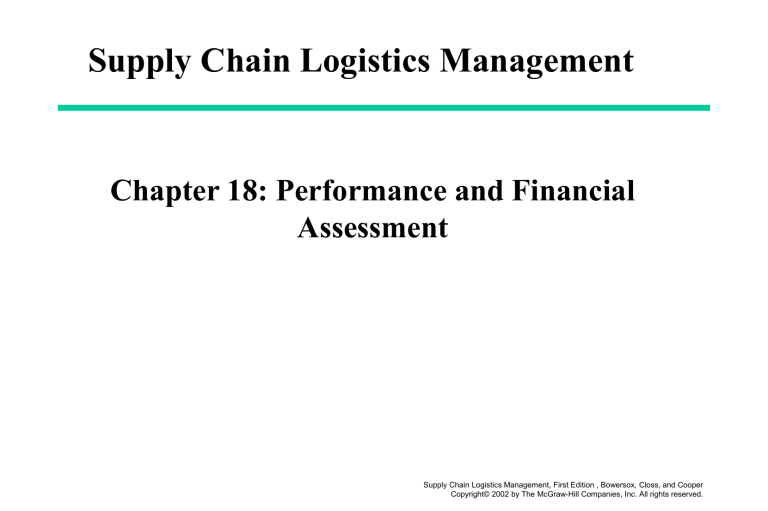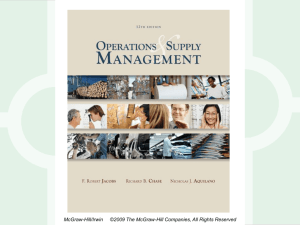
Supply Chain Logistics Management
Chapter 18: Performance and Financial
Assessment
Supply Chain Logistics Management, First Edition , Bowersox, Closs, and Cooper
Copyright© 2002 by The McGraw-Hill Companies, Inc. All rights reserved.
Shareholder Value Focus
•
•
•
•
•
Measures
Perfect Order
Dwell Time
Inventory Days
Total Landed Cost
Activity Based Cost
Increased
Customer
Service
Lowest
Landed
Total Cost
OPERATIONAL EXCELLENCE
ASSET UTILIZATION
Fixed
Capital
Reduction
Working
Capital
Reduction
•
•
•
•
Measures
Cash-to-Cash cycle time
Segment profitability
Return on assets
Free cash spin
Supply Chain Logistics Management, First Edition , Bowersox, Closs, and Cooper
Copyright© 2002 by The McGraw-Hill Companies, Inc. All rights reserved.
Traditional Functional Measurement
• Increasing scope and accuracy in functional
measurement
–
–
–
–
–
Asset Management:
Cost
Customer Service
Quality
Productivity
Supply Chain Logistics Management, First Edition , Bowersox, Closs, and Cooper
Copyright© 2002 by The McGraw-Hill Companies, Inc. All rights reserved.
TYPICAL PERFORMANCE METRICS
Customer Service
Fill rate
Cost Management
Total cost
Quality
Damage frequency
Stockouts
Cost per unit
Order entry accuracy
Productivity
Units shipped per
employee
Units per labor dollar
Shipping errors
On-time delivery
Cost as a percentage of
sales
Inbound freight
Backorders
Cycle time
Outbound freight
Administrative
Picking/ shipping
accuracy
Document/ invoicing
accuracy
Information availability
Information accuracy
Orders per sales
representative
Comparison to
historical standard
Goal programs
Productivity index
Delivery consistency
Warehouse order
processing
Direct labor
Number of credit
claims
Number of customer
returns
Equipment downtime
Response time to
inquiries
Response accuracy
Complete orders
Customer complaints
Comparison of actual
versus budget
Cost trend analysis
Overall reliability
Direct product
profitability
Customer Segment
profitability
Inventory carrying
Overall satisfaction
Cost of returned good
Sales force complaints
Asset Management
Inventory turns
Inventory levels,
number of days supply
Obsolete inventory
Return on net assets
Return on investment
Inventory classification
(A,B,C)
Economic Value Added
(EVA)
Order entry
productivity
Warehouse labor
productivity
Transportation labor
productivity
Cost of damage
Cost of service failures
Cost of
backorder
Supply Chain Logistics Management, First Edition , Bowersox, Closs, and Cooper
Copyright© 2002 by The McGraw-Hill Companies, Inc. All rights reserved.
Deficiencies of Traditional Functional
Assessment
• Bias toward cost and traditional customer service persists.
• Most logistics executives actually believe that customer service and
quality metrics reflect a customer perspective in their scorecard.
• Customer service metrics are not jointly defined.
• Metrics are “on-average, over-time”. Must be “de-averaged”.
Research shows that world-class companies emphasize absolute
metrics rather than percentages.
• Inability to reflect a true shareholder’s/financial perspective
Supply Chain Logistics Management, First Edition , Bowersox, Closs, and Cooper
Copyright© 2002 by The McGraw-Hill Companies, Inc. All rights reserved.
Internal Supply Chain:“Perfect Order”
Achievement
• The “Perfect Order” Defined
– Complete Orders Delivered To Customers Requested Date
And Time In Perfect Condition, Including All
Documentation.
– .97 x.97 x.97 x.97 x.97 x.97 x.97 x.97 x.97 x.97=.73
• Perfect Orders Should Be Assessed At Each Stage
In The Supply Chain
• Can you really capture the data?
Supply Chain Logistics Management, First Edition , Bowersox, Closs, and Cooper
Copyright© 2002 by The McGraw-Hill Companies, Inc. All rights reserved.
Internal Supply Chain: Cash-to-Cash
• Cash-To-Cash Cycle Time
– Cash-To-Cash = Total Inventory Days Of Supply + Days
Sales Outstanding - Days Payables Outstanding
Supply Chain Logistics Management, First Edition , Bowersox, Closs, and Cooper
Copyright© 2002 by The McGraw-Hill Companies, Inc. All rights reserved.
Total Supply Chain: Days of Supply
• Days Of Supply
– The Total Inventory In The Supply Chain Relationship -Inbound, Plant And All Stocking Locations In the Channel -Expressed As Calendar Days Of Supply Based On Recent
Actual Daily Rate Of Sales (or forecasted rate of sales).
• Auto Industry
• Food Industry
Supply Chain Logistics Management, First Edition , Bowersox, Closs, and Cooper
Copyright© 2002 by The McGraw-Hill Companies, Inc. All rights reserved.
Total Supply Chain: Dwell Time
• The ratio of the number of days that inventory
(or other assets) sit idle to the number of days it
is actually moving in the supply chain.
– Related to services industry measures.
Supply Chain Logistics Management, First Edition , Bowersox, Closs, and Cooper
Copyright© 2002 by The McGraw-Hill Companies, Inc. All rights reserved.
Total Supply Chain: Focus on the
Consumer
• Shelf Level In-Stock Position Is A Key Metric
For The Supply Chain
Supply Chain Logistics Management, First Edition , Bowersox, Closs, and Cooper
Copyright© 2002 by The McGraw-Hill Companies, Inc. All rights reserved.
Total Supply Chain: Total Landed Cost
Raw
Material
Source
Production
of
Components
Manufacturer
Distributors
Retailers
Could you manage your way out of the dilemma?
Supply Chain Logistics Management, First Edition , Bowersox, Closs, and Cooper
Copyright© 2002 by The McGraw-Hill Companies, Inc. All rights reserved.
Total Supply Chain: Supply Chain Response
Time
• The (theoretical) time to recognize a fundamental shift
in final customer demand, internalize that finding in all
supply chain members, re-plan, and increase/decrease
output by 20%.
– Suppose one of your recently introduced products becomes the
most successful product in its category-taking 50% market
share when your forecast was for only 20%. How long before
you actually recognize this? How long before you can arrange
production capacities, procurement and distribution
arrangements to accommodate it?
Supply Chain Logistics Management, First Edition , Bowersox, Closs, and Cooper
Copyright© 2002 by The McGraw-Hill Companies, Inc. All rights reserved.
Benchmarking
Aspects of benchmarking:
• Internal benchmarking
• Competitive benchmarking
• Non-restricted benchmarking
• Extends beyond metrics to include processes
Supply Chain Logistics Management, First Edition , Bowersox, Closs, and Cooper
Copyright© 2002 by The McGraw-Hill Companies, Inc. All rights reserved.
Segmental Analysis
To properly assess financial performance you must
segment:
By channel
By territory
By customer
By product
By supplier
Supply Chain Logistics Management, First Edition , Bowersox, Closs, and Cooper
Copyright© 2002 by The McGraw-Hill Companies, Inc. All rights reserved.
Variable Vs Fixed Expense
• VARIABLE EXPENSES
Those which change predictably with some
measure of output during a time period.
• FIXED EXPENSES
Those which do not change in relationship
to output during a time period
Supply Chain Logistics Management, First Edition , Bowersox, Closs, and Cooper
Copyright© 2002 by The McGraw-Hill Companies, Inc. All rights reserved.
Direct Vs Indirect Expense
• DIRECT EXPENSES
Those which exist due to the specific
organizational unit being analyzed.
• INDIRECT EXPENSE
Those which exist due to more than one
unit under analysis.
Supply Chain Logistics Management, First Edition , Bowersox, Closs, and Cooper
Copyright© 2002 by The McGraw-Hill Companies, Inc. All rights reserved.
Two Approaches to Profitability Assessment
• Contribution margin focuses on the variable and
direct fixed costs incurred and the contribution
that each segment makes to covering indirect
expenses and profit.
• Net profit allocates all expenses to segments.
Supply Chain Logistics Management, First Edition , Bowersox, Closs, and Cooper
Copyright© 2002 by The McGraw-Hill Companies, Inc. All rights reserved.
Activity Based Costing and Management
• ABC and ABM are allocation techniques
• Allocations are more realistic than traditional
cost accounting which relies on sales volume or
direct labor hours to allocate “overhead”.
• If you aren’t doing activity-based costing you
probably don’t know which customers, products,
services, or channels are the profitable ones.
Supply Chain Logistics Management, First Edition , Bowersox, Closs, and Cooper
Copyright© 2002 by The McGraw-Hill Companies, Inc. All rights reserved.
Sales
Strategic Profitability Model
(Dupont Model)
Gross Margin
-
$
Cost of
goods sold
Net Profit
$
Net profit
margin
(
Return on net
worth
Financial
leverage
÷
(
)
=
(
)
x
$
$
$
$
+
Indirect
expenses
$
%
x
total assets
net worth
)
Total Expenses
Sales
Return on
assets
=
net profts
net worth
-
Direct expenses
%
net proft
net sales
$
(
net profit
total assets
Inventory
)
Sales
Assets turnover
$
$
Current assets
$
Total assets
$
+
Fixed assets
$
+
Accounts
receivable
$
+
Other current assets
$
Supply Chain Logistics Management, First Edition , Bowersox, Closs, and Cooper
Copyright© 2002 by The McGraw-Hill Companies, Inc. All rights reserved.
SPM RATIOS FOR TWO FICTITIOUS RETAILERS
Return on
net worth
Company A
Company B
26.1
24.6
Leverage
5.55
2.73
Return on Asset
assets
turnover
5.5
10.5
2.20
1.99
Net profit
margin
2.9
6.2
Supply Chain Logistics Management, First Edition , Bowersox, Closs, and Cooper
Copyright© 2002 by The McGraw-Hill Companies, Inc. All rights reserved.
SALES
Price
x
Strategic Profit Model
GROSS MARGIN
Quantity
-
500
(BASE CASE)
2000
COST OF GOODS SOLD
Cost of goods
1500
x
NET PROFIT
NET PROFIT MARGIN
5%
(
net profit
net sales
)
-
100
÷
DIRECT EXPENSE
TOTAL EXPENSES
SALES
2000
Quantity
300
+
400
Transportation
Handling
Storage Space
Promotion
etc.
INDIRECT EXPENSE
100
RETURN ON ASSETS
TIMES
10%
INVENTORY
SALES
400
2000
+
ASSET TURNOVER
÷
2
TOTAL ASSETS
(
net sales
total assets
)
1000
CURRENT ASSETS
ACCOUNTS RECEIVABLE
100
600
+
FIXED ASSETS
400
+
OTHER CURRENT ASSETS
100
Supply Chain Logistics Management, First Edition , Bowersox, Closs, and Cooper
Copyright© 2002 by The McGraw-Hill Companies, Inc. All rights reserved.
SALES
Strategic Profit Model
GROSS MARGIN
-
500
(INVENTORY REDUCTION)
2000
COST OF GOODS SOLD
1500
NET PROFIT
NET PROFIT MARGIN
6%
(
net profit
net sales
)
120
÷
VARIABLE EXPENSES
TOTAL EXPENSES
SALES
2000
280
+
380
FIXED EXPENSES
100
RETURN ON ASSETS
13.32%
TIMES
INVENTORY
SALES
300
2000
+
ASSET TURNOVER
÷
2.22
TOTAL ASSETS
(
net sales
total assets
)
900
CURRENT ASSETS
ACCOUNTS RECEIVABLE
100
500
+
FIXED ASSETS
400
+
OTHER CURRENT ASSETS
100
Supply Chain Logistics Management, First Edition , Bowersox, Closs, and Cooper
Copyright© 2002 by The McGraw-Hill Companies, Inc. All rights reserved.
SALES
Strategic Profit Model
GROSS MARGIN
-
500
(EXPENSE REDUCTION)
2000
COST OF GOODS SOLD
1500
NET PROFIT
NET PROFIT MARGIN
÷
6.25%
net profit
net sales
(
125
VARIABLE EXPENSES
TOTAL EXPENSES
SALES
)
+
375
2000
275
FIXED EXPENSES
100
RETURN ON ASSETS
12.5%
TIMES
INVENTORY
SALES
400
2000
+
ASSET TURNOVER
.
÷
2
TOTAL ASSETS
(
net sales
total assets
)
1000
CURRENT ASSETS
ACCOUNTS RECEIVABLE
100
600
+
FIXED ASSETS
400
+
OTHER CURRENT ASSETS
100
Supply Chain Logistics Management, First Edition , Bowersox, Closs, and Cooper
Copyright© 2002 by The McGraw-Hill Companies, Inc. All rights reserved.
Dream Beauty Case Discussion
• Activity Based Management
• Strategic Profit Model
Supply Chain Logistics Management, First Edition , Bowersox, Closs, and Cooper
Copyright© 2002 by The McGraw-Hill Companies, Inc. All rights reserved.












